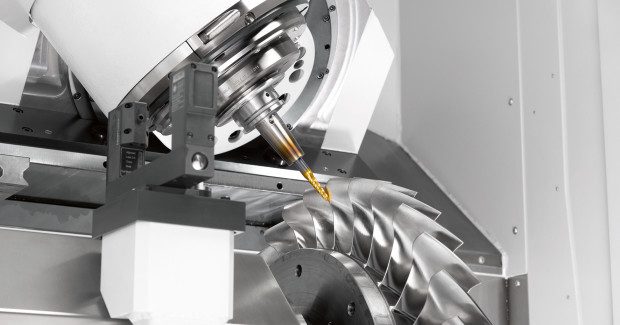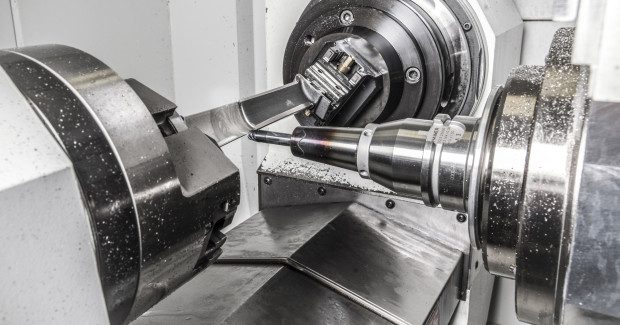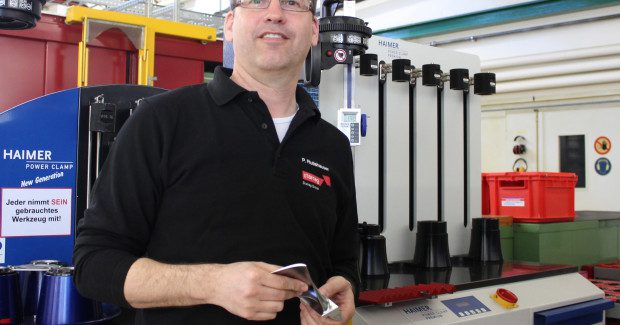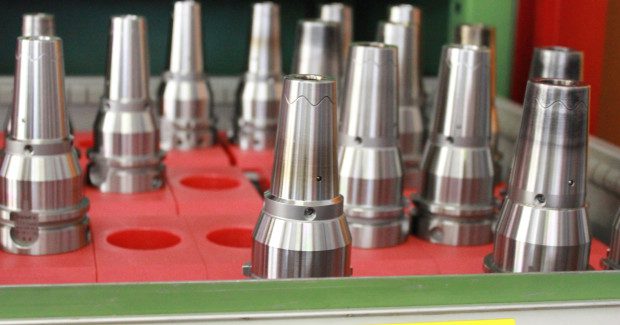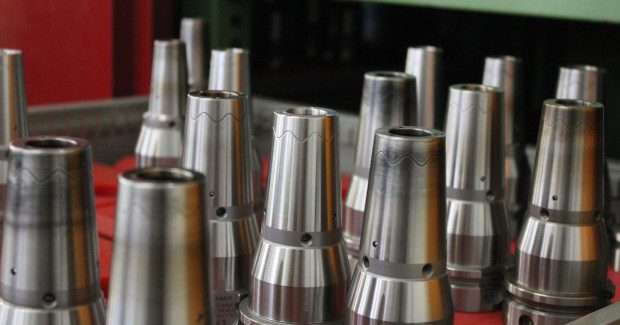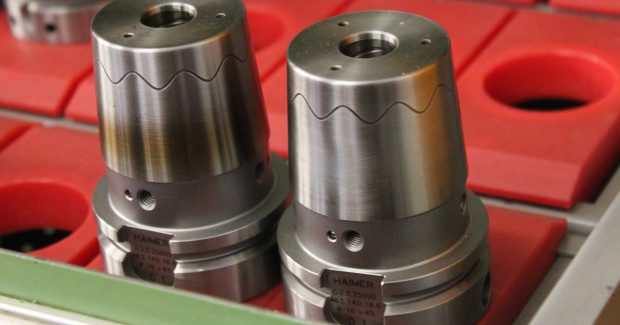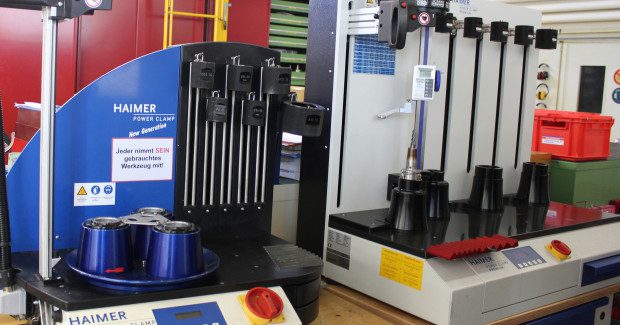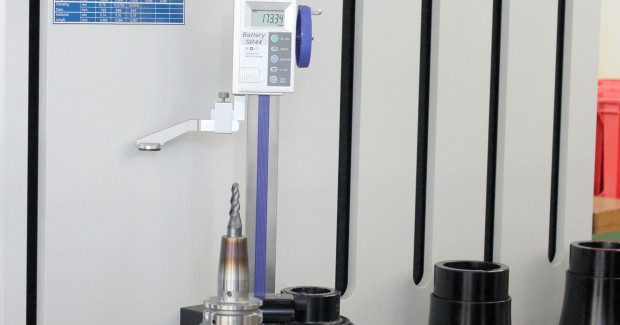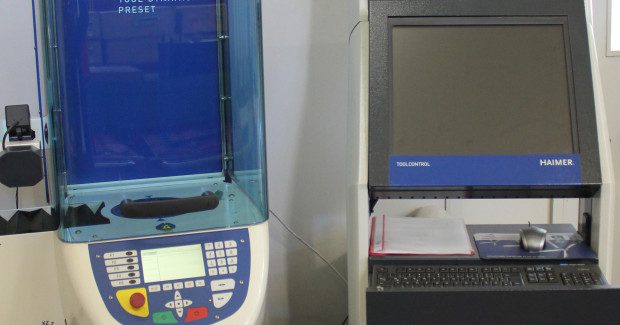How Shrink Fit Chucks Fit Single Blade Applications
See why Starrag uses shrink fit chucks so their rotationally symmetric clamping body has less interfering contours and higher run-out accuracy when roughing and finishing hard-to-cut materials used for highly precise turbine blades, impellers, blisks and other structurally complex parts.
Posted: October 5, 2015
“Haimer professionalized the shrinking process.”
Since the beginning of the 20th century, the aerospace industry has been the core market for machine tools from Starrag Group AG (Rorschacherberg, Switzerland), which distinguished its machinery from other competitors through a rigid and robust design merged with a high technological standard that led to the pioneering of 5-axis simultaneous machining in the 1960s. This machine tool manufacturer, which has 1,617 employees and around $401.7 million in revenue in 2014, develops and builds a broad range of machines for milling, drilling and grinding metal parts, composite material and ceramics in aerospace and energy, transportation and industrial components, and precision engineering applications. These range from small high speed machining centers from Bumotec, which are suited for cutting components in the watch, medical, and computer industry, up to the gantry machines from Droop-Rein, which are many meters long, can fill an entire hall, and are ideal for working on big, heavy parts.
With a primary focus on aerospace and energy applications, Starrag offers 5-axis machining centers capable of high metal removal rates in order to produce highly precise turbine blades, impellers, blisks and other structurally complex parts. These include machine tools such as the STC and BTP series for titanium machining, machining centers that are specialized in blisk cutting, and the LX series, which is especially designed for the highly precise, efficient and simultaneous 5-axis machining of turbine blades.
“Technologically speaking, these machines are of premium quality,” notes Patrick Rutishauser, the head of application engineering of Starrag. “They are known for high performance capacity and precision that offers shops additional value regarding the specific application. When a shop approaches us with a component that they must produce in quantities of 10,000 pieces, we design the complete system for them and supply the machine tool, including software, clamping fixtures, tool holders, as well as peripheral components and machine accessories.”
His tasks include technology and software development for so-called Single Blade Applications. His application engineers work hand-in-hand with CAM software developers to provide end-users with exactly what they need, without taking any detours or wasting time. This team gains important experience at the 2,000 sq m Center of Production Excellence (CPE) application center in Rorschacherberg, where they test and optimize demanding new machining processes on new 4-axis and 5-axis Starrag machining centers, ranging from heavy duty cutting of highly solid titanium alloy up to high speed cutting of light metal. They work on rotating parts, complex cubic work pieces, as well as free-formed flow surfaces – all of this under production conditions. They also produce prototype and small series for customers.
These applications entail developing a drawing and quality production at reasonable costs in the market, an advantage that enables Starrag to acquire valuable knowledge about specific machine requirements and examine each integral machining process down to the smallest detail, much different from customer demonstrations that usually overlook minor details.
TOOL HOLDING
Starrag has known for a long time that tool holding is a very important issue when it comes to high precision machining. After all, they were using a 30,000 rpm high speed spindle in Rorschacherberg 20 years ago. At that time, cutting tools were usually clamped with Weldon or Whistle-Notch holders and collet chucks that led to many problems because of insufficient run-out accuracy. At high rotational speeds, even small deviations could lead to poor milling results, an inferior surface quality, as well as tool and spindle wear. The geometry of those tool holders also involved many interfering contours that made it impossible to reach deep cavities with minimally clamped tools.
Based on the testing of different tool holding systems, it became necessary to use shrink fit chucks in order for their rotationally symmetric clamping body to have less interfering contours and a high run-out accuracy. During the initial tests with the new clamping technology, some weaknesses had to be overcome: at that time, the chucks were heated up with hot air, which was very time consuming and placed great strain on the material. About 15 years ago, in search of a solution to this issue, the company came across Haimer GmbH (Igenhausen, Germany), a specialist in tool holding technology that offered a large selection of tool holders and a shrinking machine with an inductive coil and cooling bodies that were easy to handle.
SHRINK FIT CHUCKS
“When it comes to their shrinking technology, we appreciate the potential of clamping tools with short projection lengths and slim contours in comparison to other clamping systems,” says Rutishauser. To keep their shrink fit precision under control 100 percent of the time, Haimer only manufactures in Igenhausen, where all shrink fit chucks, even the standard ones, are made out of heat resistant steal and are fine balanced at G2.5 at 25,000 rpm < 1 gmm unbalance. The functional surfaces are machined and ground extremely accurately and the taper tolerance is much more precise compared to the relative norm.
Special shrink fit chucks are offered for special machining requirements. For example, the patented design of Power Shrink Chucks combines a low tendency towards vibration with a high rigidity and a slim design on top that makes it possible for the operator to increase the cutting depth and the feed and reach a higher cutting volume while still maintaining a good surface quality, which is suitable for special high speed or high precision milling applications. Heavy Duty Shrink Chucks are especially designed for heavy machining with large cutting tools. They feature a reinforced wall thickness at the clamping area, a very rigid outer contour and patented expansion grooves in the clamping bore to reach high clamping forces comparable to those of milling chucks. There are also small Mini Shrink Chucks, which are one-piece shrink fit chucks with an extremely slim design and a 3 deg outer contour designed for mold making.
DIFFICULT MATERIAL, HIGH SURFACE REQUIREMENTS
Rutishauser uses this variety of shrink fit holder designs as a competitive advantage. “During the blade production made of extrusion profiles, there are generally two procedures,” he explains. “First, it starts with a rough cutting process where it is important that the chuck operates with a damping component in order to achieve a high cutting depth and feeds and to remove as much material as possible in one production stage. During the finishing process, however, there aren’t any strong cutting forces. At this point, a high runout accuracy and the balancing quality are important. Power Shrink Chucks are ideally suited for both processes. If the cutting gets even tougher, we simply switch to Heavy Duty Chucks.”
The best shrink fit chuck quality is required due to the fact that, during the roughing and finishing machining of titanium and other hard-to-cut materials, the cutting forces can be very aggressive on the interface between the machine spindle and the tool holder. “In the end, the key element is the part quality. It must be perfect starting from the very beginning, because even the titanium blanks cost a small fortune. We are convinced that tool holder quality is absolutely essential for the part quality,” adds Rutishauser. This is especially true regarding the surface quality, which is important because the turbine blades need a highly precise structure in order to be very energy efficient. This way, Starrag can get the desired structure through milling, without any additional regrinding, by achieving a surface quality of Ra = 0.8 μm to 0.4 μm.
HIGH-END-SHRINKING FOR FAST, EASY TOOL CLAMPING
In order to shrink tools, the Power Clamp Profi Plus NG used in the CPE application center can shrink all HSS and solid carbide tools with shank tolerance h6 and diameter 3 mm up to 50 mm within a matter of seconds. It is equipped with a patented double coil technology, where the coil adapts itself to the length and diameter of the shrink fit chuck. During the shrinking process only the shrinking area is heated, which significantly reduces the heating and cooling time via contact cooling. There is also a Power Clamp high-end solution for professional shrinking and cooling, a premium machine that offers a spacious work surface, easy handling and linear guided cooling bodies with temperature monitoring. The machine at Starrag has an integrated length presetting – holding lengths exactly within 0.02 mm – since tools must always be shrunk to a precisely defined overhang length.
“These shrink fit chucks are part of our standard equipment because they offer the best conditions for process reliable cutting,” states Rutishauser. “We don’t just use these products at our CPE, we also sell them together with our own systems because it is important that the quality of the products always remains high. We feel secure with these chucks. I can’t remember a single incident where a tool holder was the reason for a customer complaint.”
Starrag Group AG, Seebleichestrasse 61, 9404 Rorschacherberg, Switzerland, +41 71 858 81 11, www.starrag.com.
Haimer USA, LLC, 134 E. Hill Street, Villa Park, IL 60181, 630-833-1500, Fax: 630-833-1507, haimer@haimer-usa.com, www.haimer-usa.com.



